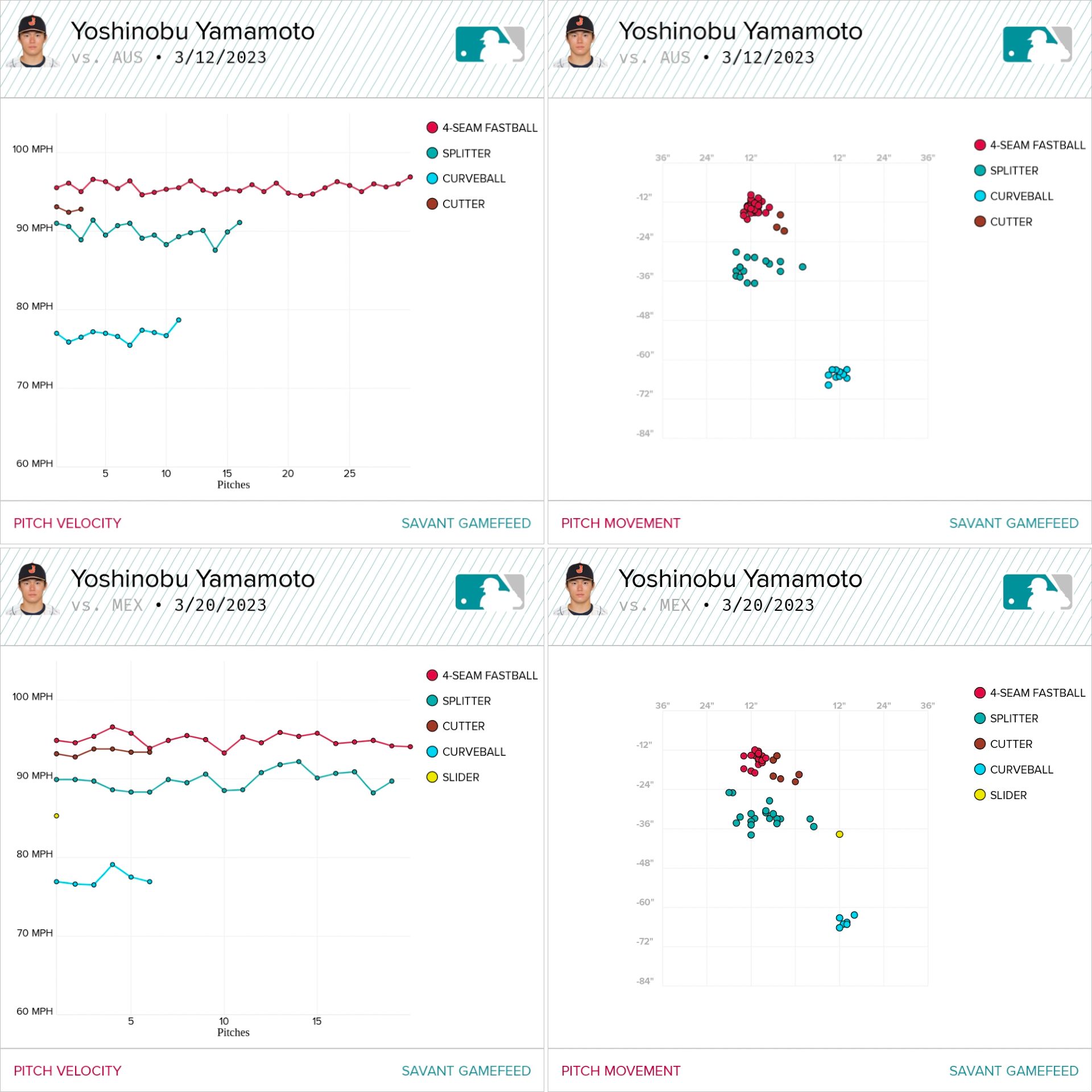We're finally going to get to see what Yoshinobu Yamamoto can do in the Major Leagues -- but MLB fans have already gotten to see the Japanese superstar pitcher on the big stage.
Yamamoto was the ace of Samurai Japan at the 2023 World Baseball Classic. That means we got a sneak peek at what the 25-year-old right-hander can bring to the Dodgers' rotation now that he has agreed to a 12-year, $325 million contract with the club, a source told MLB.com's Mark Feinsand.
The WBC games were equipped with Statcast tracking, so we got an early look at Yamamoto's stuff. And his stuff looks good. Really good.
Here's a dive into the early Statcast data we have on Yamamoto's arsenal, which includes shades of new teammate Shohei Ohtani and longtime Dodgers ace Clayton Kershaw, among others.
All Statcast data for Yamamoto below is from the World Baseball Classic.

Yamamoto's fastball
- Velocity: 95.3 mph (max velo: 96.9 mph)
- Spin rate: 2,269 rpm
- Vertical drop: 13.2 inches
- Horizontal break: 11.0 inches
Yamamoto showed his high-velocity, running four-seamer in the WBC. His fastball averaged over 95 mph in his two outings -- almost 2 mph faster than the average big league starter -- and touched 97.
The 11 inches of run he was getting was also well above average for an MLB four-seamer, and we also saw him generate excellent "rise" on certain fastballs to get swings-and-misses -- like when he struck out Australia's Ulrich Bojarski with a 96.1 mph, 2,477 rpm four-seamer that only dropped nine inches on its way to the plate.
You could compare that to an MLB fastball like Kevin Gausman's: In 2023, the Blue Jays ace averaged about 95 mph on his four-seamer with 14 inches of drop and 11 inches of run, a similar example of a running fastball with carry.
And for Yamamoto, that's only a two-game sample from the very beginning of the year. We know from his NPB games that Yamamoto's rising fastball will sit in the mid-90s but often reach the upper-90s.
Yamamoto's curveball
- Velocity: 77.0 mph (max velo: 79.1 mph)
- Spin rate: 2,809 rpm
- Vertical drop: 65.8 inches
- Horizontal break: 14.2 inches
But let's get to the signature pitch: Yamamoto's rainbow curveball.
While Yamamoto throws a wipeout splitter like many Japanese aces -- Ohtani, Kodai Senga, Masahiro Tanaka, Roki Sasaki and so on -- his most fun pitch to watch is the curve.
Yamamoto's curveball, visually, is like the Kershaw curveball of Japan: It's a beautiful pitch. But really, from the tracking data, it looks like it's somewhere between Kershaw's, Max Fried's, Adam Wainwright's and Yu Darvish's, with its combination of mid-to-upper 70s velocity, big vertical movement and swooping break.
- Kershaw's curveball: 73 mph, 67" drop, 4" break
- Fried's curveball: 74 mph, 67" drop, 9" break
- Wainwright's curveball: 72 mph, 68" drop, 17" break
- Darvish's curveball: 76 mph, 62" drop, 11" break
There's nothing like when a big looping curveball like Kershaw's freezes a hitter. Yamamoto can do exactly that. Like when he buckled Joey Meneses' knees with a 77 mph curveball that dropped 65 inches and broke 14 inches in the WBC semifinal against Mexico.
Ohtani has the sweeper. Senga has the ghost fork. Yamamoto has the curve.
Yamamoto's splitter
- Velocity: 89.8 mph (max velo: 92.2 mph)
- Spin rate: 1,522 rpm
- Vertical drop: 32.8 inches
- Horizontal break: 9.6 inches
Yamamoto's curveball is the beautiful pitch, but his splitter might be his nastiest offering.
It's the one he goes to for K's, and it's a wipeout split-finger just like Ohtani's or Sasaki's -- a high-velocity "offspeed" pitch that frequently breaks into the 90s, with drop-off-the-table downward movement.
Of Yamamoto's 11 strikeouts in the World Baseball Classic, seven came on splitters (the other four came on fastballs). Of the 19 swinging strikes he induced in the WBC, 11 came on splitters. His opponents whiffed on just under half their swings against his split.
From a velocity and movement standpoint, Yamamoto's splitter is a lot like Ohtani's -- and Ohtani's has been overwhelming hitters ever since he got to the Majors.
Ohtani's splitter in 2023 averaged 89 mph and 1,305 rpm with 31 inches of drop and 8 inches of break, very close to Yamamoto's splitter profile from the WBC.
Yamamoto's cutter
- Velocity: 93.2 mph (max velo: 93.8 mph)
- Spin rate: 2,470 rpm
- Vertical drop: 18.3 inches
- Horizontal break: 2.5 inches
Yamamoto's fourth pitch is a hard slider/cutter hybrid, like a lot of power pitchers in the Major Leagues today.
It's not as nasty of a strikeout pitch as his splitter, but it's another effective secondary offering thanks to its high velocity for a pitch that's not his primary fastball. (This pitch for Yamamoto is more cutter than slider; separately, he'll mix in a rare mid-80s "sweeper" style of slider.)
Yamamoto's cutter sits in the low 90s with tight movement, making the pitch function something like Nathan Eovaldi's cutter, which averages about 91 mph with just an inch or two of break.
Usage-wise, though, it's probably more like Gerrit Cole's cutter -- which is also a high-velo, tight-movement cutter, but more of a tertiary pitch, used behind his other big out pitches.
Soon, we should have a lot more information with which to further study Yamamoto. But from the preview we've already gotten, we can see that he has the stuff to be a dominant MLB pitcher like Senga, Ohtani and the other NPB aces who've made the jump.
